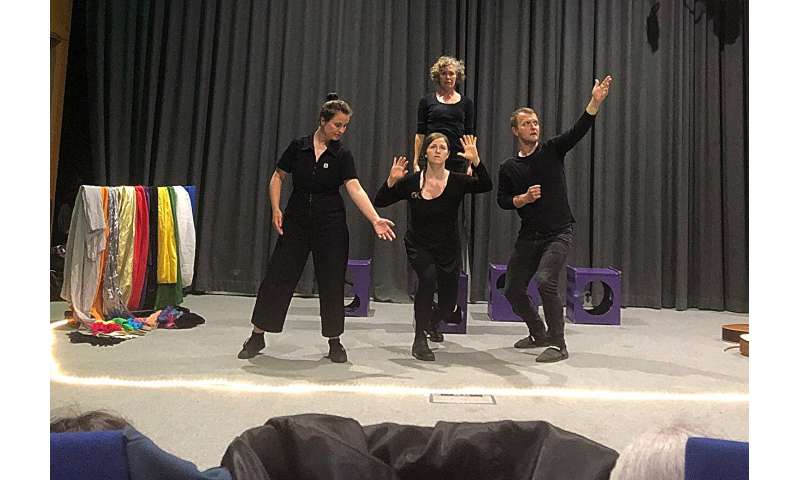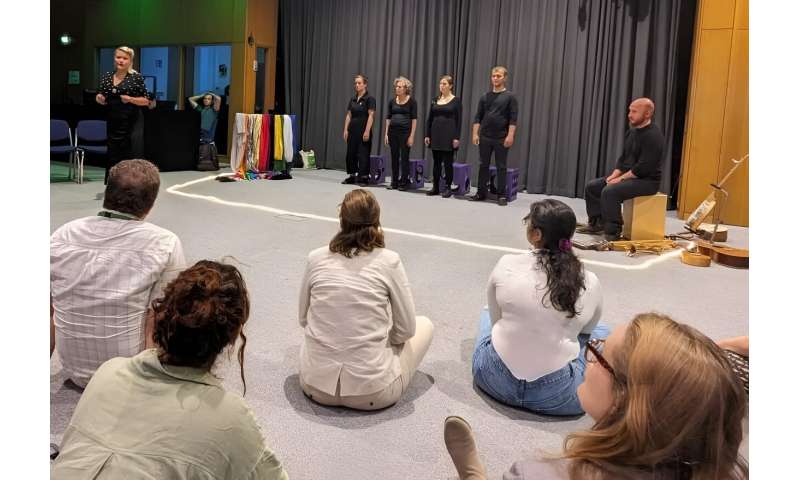When theatre tackles the effects of climate extremes: the "science-art" approach to disaster risk reduction

Natural hazards claimed almost 60,000 lives in the first half of 2023 alone, and global warming is expected to trigger more extreme events in the coming years. "Breaking the silos" by combining theatre and science is one of the strategies being tested to prevent increasing losses and optimize disaster risk reduction
Put a bunch of people in a theatre room, all having endured a trauma such as surviving a flood. If you ask them to recall their experiences, they will first be intimidated and just sit there, doing nothing and each of them will feel isolated in their perception. But then, with actors starting to move on stage to loud music and repetitive sounds, emotions begin flowing and tongues loosening. A first personal story is shared publicly and then enacted by actors and musicians. By doing so, the participant who shared their experience gets engaged at an emotional level and is led to see it from a different perspective. Then one by one the other spectators react. The first story is followed by a second and a third and, through storytelling, understanding gets progressively enriched and becomes a collective process. "What happens is that the individual aspect fades, and as personal stories become universal, other people can recognize something of their own experience in them," explains Lou van Laake, co-leader with Marcin Pietruszka of the Full Circle Playback Theatre in Dublin, Ireland.
"Playback Theatre" is an art form started in 1975 in New York as pure entertainment and utilized since also therapeutically and for other purposes, such as fostering knowledge sharing and a sense of community. Within The HuT, a European project aimed at developing innovative tools and strategies to better cope with risks associated with climate extremes, it is also employed to investigate the "human factor", affecting the response in the event of natural disasters. Anna Smetanova is a Strategic Project Manager for the Global Water Partnership, an international NGO working globally in 180 countries and partnering with the project: "We may have perfect early warnings, but despite that, when disasters occur, people often end up not following the instructions. This is a typical situation where Playback Theatre can help investigate the emotional level and thus understand why people react that way, instead of following the procedures," she asserts.

According to figures by the European Environment Agency, from 1980 to 2020 natural hazards affected almost 50 million EU citizens and have cost Member States on average €12 billion per year. With global warming expected to trigger more extreme events in the coming years and global losses estimated at €100 billion in the first half of 2023 alone, experts agree that optimising so-called "disaster risk reduction" is now imperative. "When it comes to transferring innovation into praxis, the state-of-the-art shows that the nexus among technology, human behaviour, and policies must be strengthened. This is why we aim at deepening the connection between these aspects, especially relating to early warning systems and multi-hazard disaster risk reduction," states Smetanova. Within this framework, she explains, the Playback Theatre is part of a broader and innovative approach combining science and art: "They are disciplines allowing the understanding of human behaviour from different perspectives: science through knowledge and technology, and art through leveraging inner creativity and metaphors, capable of bringing out personal stories that would otherwise be relegated to an unconscious level".
Considered by experts as pivotal to reducing both human losses and costs, the shift in focus from "managing disasters" to "managing risk" is among the priorities of the (UNDRR). "We are increasingly seeing that ," remarks its Chief of Communication and IT, Jeanette Elsworth. "So, it must no longer be only the seismologist thinking about how the earthquake will happen, but also the planning organisations, the health sector, and all the different players who could be impacted." , explains its deputy coordinator Guido Rianna: "One of the key aspects is going beyond sectoral innovation and fostering a coordinated approach, which takes into account a whole set of different skill sets: human behaviour, governance, science & technology, etc."
To reduce the risk of disasters as much as possible, it is therefore crucial to "break the silos" at various levels. "Some existing practices to deal with specific disasters may already be effective but unknown to other communities that face similar challenges," explains Michele Calvello, Associated Professor of geotechnical engineering at the University of Salerno and The Hut's coordinator. "So, one of our main actions consists in fostering transdisciplinarity, cross-fertilization, and knowledge sharing, to promote the best set of practices among different sectors and communities." Under severe threat from debris flows and flash floods, the picturesque Amalfi Coast, in southern Italy, is one of the 10 European areas where this approach is tested, ahead of a possible replication on a wider scale. "They obviously already have emergency procedures in place, but we help the municipality improve its response by putting in place additional monitoring tools to complement their information and organizing educational meetings to better explain to their civil protection staff what to expect during emergency phases," explains Calvello.
If community engagement is paramount it's also because "disaster risk reduction is in everything we do", highlights Elsworth: "We are all responsible for contributing and acting, and we need everybody, on every level and in every sector to be acting on that. If we say 'natural disaster' it's as if we were speaking of something that couldn't be avoided, whilst a lot depends on the human element. We always have decisions to make: how to develop our urban areas, whether to build or not in earthquake or flood- prone areas, etc." Key for the effectiveness of any solution is, therefore, its "integration at the policy and governance level," asserts Calvello: "This is where interaction is often lacking today, and this is why we are also trying to foster this collaboration from the very beginning, instead of just presenting ready-to-use solutions." In this respect, one of the biggest challenges is the contradiction between the timelines of natural hazards and political timelines, points out Elsworth: "It's very hard to convince someone who has a much shorter time frame, very limited budget and lots of conflicting demands, to invest in preventing the risks related to a hazard which may happen in 10 years or may not happen at all." Yet, increasing investments in disaster risk reduction would not only drastically reduce human losses, but also costs for recovery and damage mitigation, concludes Elsworth: "Our figures prove that if we moved that funding upstream, each dollar invested could pay off up to 60 times, depending on the context."
Provided by iCube Programme